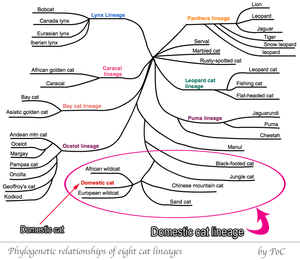Cat Breed Evolution
Introduction
The evolution of domestic cat breeds is a long and interesting tale that started in 7500 BC in what was then called the Near East. These cats began their descent into the common domestic cat around 4400 BC when they began a mutually beneficial relationship with the earliest farmers.[1] In return for helping control rodent populations and providing company, these animals got food and protection from the elements. Different breeds began to appear when artificial selection led to the wide range in size, color, and behavior shown in modern day cats, whose Latin name is Felis catus.
There are many different ideas on how cats evolved to become domesticated like they are today. The most prevalent idea is that cats were able to board shipping line ships and travel around the world starting in 2000 BCE.[2] These cats stayed by the human’s side as feral pets, but were never fully controlled. They still hunted for their own food and bred how they wanted. This great migration of cats began in Western Asia and spread to Western Europe, the Mediterranean, and Africa.
Over time, around 1700 BCE, the demand for Egyptian cats increased 10 fold because of their beautiful fur and friendly dispositions. This led to a “cat trading ban” around 1500 BCE but by that time, cats had infiltrated most homes, hunting parties, and cities.[3]

Section 1 Genetics
Genetic analysis has found that cats mostly domesticated themselves until around 100 BCE and there are striking similarities and differences between today’s house cat and past wild cats, as well as domesticated cats. As such, physical evolution is not the only type that occurred in these nine thousand years and researchers are now able to identify the genes that have changed. Since the beginning of their domestication, over 281 genes have mutated rapidly and sometimes multiple times. These genes are responsible for a cat’s hearing, metabolism, eye-sight, and even diet.
However, the most important genes that have shifted a wild cat to a domestic cat were found when comparing domestic cats to their ancestors who still roam Europe. These 13 genes are responsible for the cat’s cognition, identification of danger or prey, fear, and ability to recognize rewards and commands. In order to accomplish these tasks, the genes code for glutamate receptors, which are shown to be responsible for learning and memory in humans as well. These genes were present in the ancient cats who dared to board a ship with humans and have since evolved into a standard piece of DNA found in every house cat.
Another five genes that have been recently sequenced show that they affect the migration of stem cells in developing embryos which can explain common traits of domesticated animals such as smaller brains, lowered hunting ability, and different fur patterns.
Fur is another trait that has genetically evolved to be where it is today. Long, “regal-looking” stripes of dark and tawny variations have been present since ancient times on wild cats and tabby cats. However, when tabby cats and calico cats started to develop splotches of fur instead of defined stripes, scientists identified one common factor: a mutated gene. This gene is called Taqpep. This gene is responsible for the spacing and shape of the splotches but not the color. A different mutation has been found on the Edn3 gene that is shown to be responsible for black coloration not previously found in the wild. As Taqpep levels are increased throughout the entire gestation period but fur patterns only appear in week 7, it is proposed that it is solely responsible for the establishment of a spotted or striped pattern with Edn3 coming later to establish color. This is why the number of spots or stripes on a house cat does not change throughout its entire lifespan. Also, along with other factors such as ear hair, size of cat, nose shape, and more, these two genes are responsible for the differentiation of over 20 domesticated cat breeds.
Sample citations: [4]
[5]
A citation code consists of a hyperlinked reference within "ref" begin and end codes.
Section 2 Microbiome
Include some current research, with a second image.
Conclusion
Overall text length (all text sections) should be at least 1,000 words (before counting references), with at least 2 images.
Include at least 5 references under References section.
References
- ↑ Smith, Casey. “Cats Domesticated Themselves, Ancient DNA Shows.” Science. National Geographic, May 3, 2021.
- ↑ “How Did Cats Become Domesticated?” The Library of Congress. Accessed December 8, 2021.
- ↑ Annalee Newitz - Jun 19, 2017 8:01 pm UTC, and Aged Ars Veteran Wise. “Cats Are an Extreme Outlier among Domestic Animals.” Ars Technica, June 19, 2017.
- ↑ Hodgkin, J. and Partridge, F.A. "Caenorhabditis elegans meets microsporidia: the nematode killers from Paris." 2008. PLoS Biology 6:2634-2637.
- ↑ Bartlett et al.: Oncolytic viruses as therapeutic cancer vaccines. Molecular Cancer 2013 12:103.
- ↑ Lee G, Low RI, Amsterdam EA, Demaria AN, Huber PW, Mason DT. Hemodynamic effects of morphine and nalbuphine in acute myocardial infarction. Clinical Pharmacology & Therapeutics. 1981 May;29(5):576-81.
Edited by Katianna Blackwell-Scott, student of Joan Slonczewski for BIOL 116 Information in Living Systems, 2021, Kenyon College.
